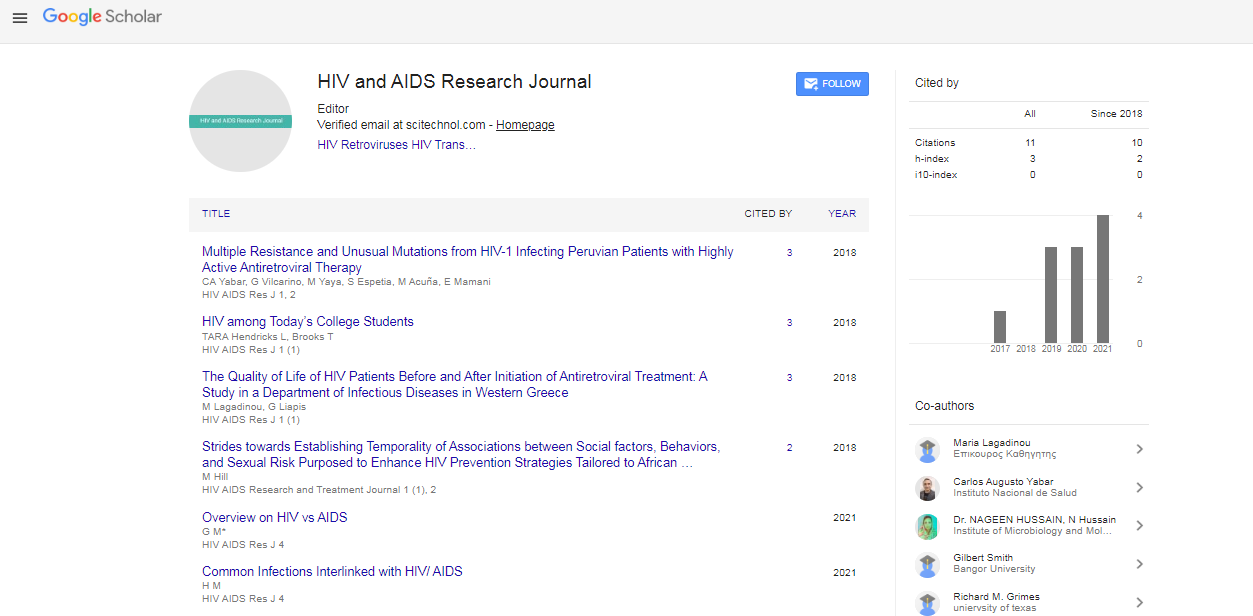Perspective, Hiv Aids Res J Vol: 6 Issue: 4
Navigating the Intricacies: The Dynamic Interplay of HIV and the Immune System
William Daniel*
1Department of Medicine, University of Queensland, Queensland, Australia
*Corresponding Author: William Daniel,
Department of Medicine, University of
Queensland, Queensland, Australia
E-mail: williamdaniel@uni.edu.au
Received date: 04 December, 2023, Manuscript No. HARJ-24-124123;
Editor assigned date: 06 December, 2023, PreQC No. HARJ-24-124123 (PQ);
Reviewed date: 20 December, 2023, QC No. HARJ-24-124123;
Revised date: 28 December, 2023, Manuscript No. HARJ-24-124123 (R);
Published date: 05 January, 2024 DOI: 10.4172/Harj.1000135
Citation: Daniel W (2024) Navigating the Intricacies: The Dynamic Interplay of HIV and the Immune System. HIV AIDS Res J 6:4.
Description
The immune system is a sophisticated defense mechanism that safeguards the body against pathogens, but its confrontation with the Human Immunodeficiency Virus (HIV) presents a complex and evolving challenge. The immune system comprises innate and adaptive components working in concert to combat pathogens. The innate immune response provides immediate, nonspecific defenses, while the adaptive immune response orchestrates targeted and specific responses to pathogens encountered.
HIV's encounter with the immune system
HIV, specifically targeting CD4+ T lymphocytes, infiltrates the immune system, compromising its function and leading to progressive immune system decline.
Viral entry and CD4+ T cell targeting: HIV gains entry into the body by binding to CD4 receptors primarily found on CD4+ T cells, dendritic cells, and macrophages. Upon entry, the virus selectively infects and destroys CD4+ T cells, crucial orchestrators of immune responses.
Immune evasion and replication: HIV's ability to mutate rapidly enables evasion of immune responses. It continuously replicates, resulting in a high viral load and causing a decline in CD4+ T cell counts.
HIV-mediated immune dysfunction
HIV infection leads to a gradual breakdown of the immune system, compromising its ability to fight off infections and malignancies.
CD4+ T cell depletion: HIV's assault on CD4+ T cells leads to their depletion, progressively weakening the immune response. A decline in CD4+ T cell counts leaves the body vulnerable to opportunistic infections and cancers.
Chronic immune activation and inflammation: HIV induces persistent immune activation and inflammation, even in the absence of opportunistic infections. This chronic activation leads to immune exhaustion and contributes to accelerated aging and increased risk of non-AIDS-related complications.
Dysregulation of immune responses: HIV disrupts the balance of immune responses, impairing the coordination between various immune cells and signaling molecules, which is essential for an effective defense against pathogens.
Immune responses in HIV control and persistence
While the immune system mounts an initial response to HIV, the virus employs various mechanisms to evade and persist within the host.
Antibody and cellular response: The immune system generates antibodies and mounts a cellular response against HIV. However, the virus evolves rapidly, evading neutralizing antibodies and persisting within reservoirs, such as latently infected CD4+ T cells.
Role of Cytotoxic T Lymphocytes (CTLs): CTLs play a crucial role in controlling HIV by targeting and eliminating infected cells. However, the continuous mutation of the virus and its ability to hide within host cells contribute to CTL exhaustion and viral persistence.
Implications for HIV treatment and prevention
Understanding the intricate interaction between HIV and the immune system is pivotal in shaping treatment strategies and preventive measures.
Antiretroviral Therapy (ART): ART suppresses viral replication, reduces viral load, and preserves immune function. Timely initiation and adherence to ART are crucial for controlling HIV and preventing immune decline.
Vaccines and immunotherapies: Ongoing research aims to develop vaccines that stimulate immune responses against HIV. Immunotherapies targeting immune activation or boosting specific immune responses are also under investigation.
Preventive measures: Promoting early diagnosis, access to treatment, and adherence to preventive strategies such as PrEP (Pre- Exposure Prophylaxis) are pivotal in controlling the spread of HIV and preserving immune health.
Conclusion
The battle between HIV and the immune system epitomizes the complexities of viral infections and immune responses. HIV's ability to evade, persist, and compromise the immune system poses significant challenges in managing the infection. Continued research, innovation in therapies, and preventive measures remain critical in the quest for effective HIV control, immune restoration, and ultimately, the eradication of this global health threat.
 Spanish
Spanish  Chinese
Chinese  Russian
Russian  German
German  French
French  Japanese
Japanese  Portuguese
Portuguese  Hindi
Hindi 